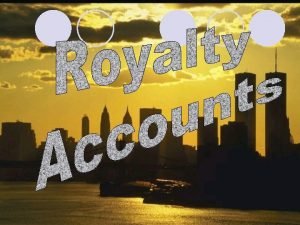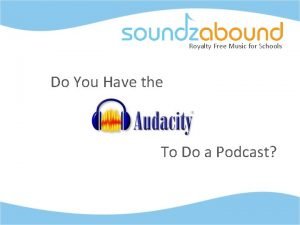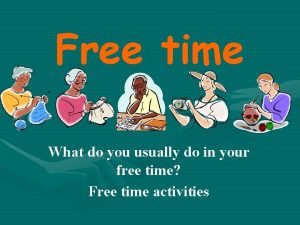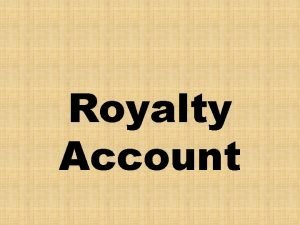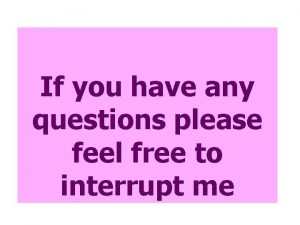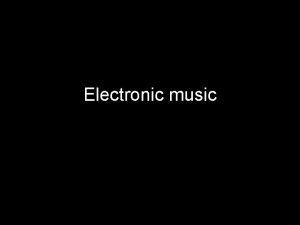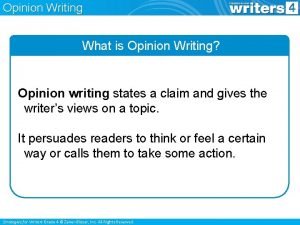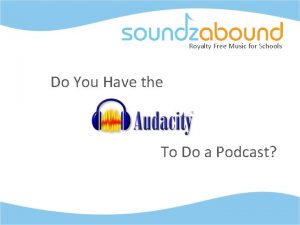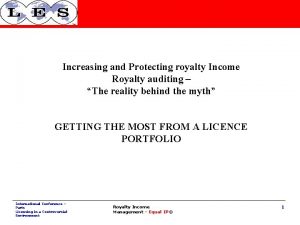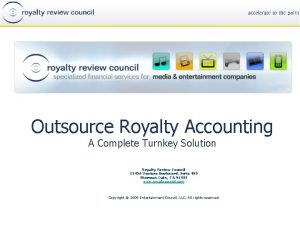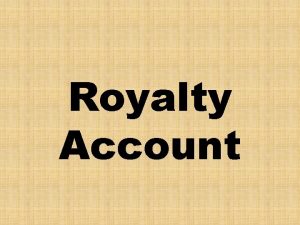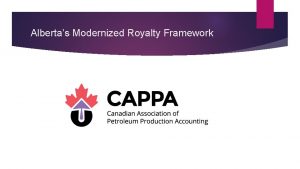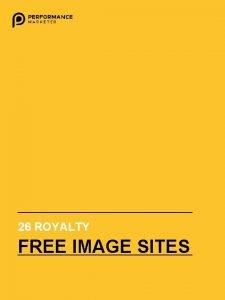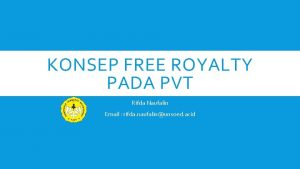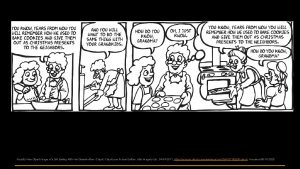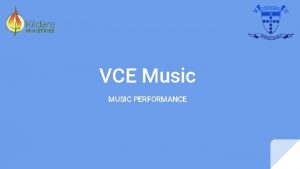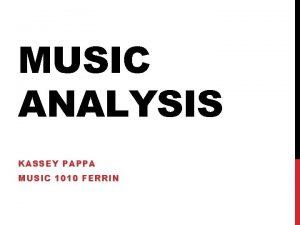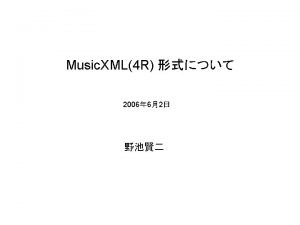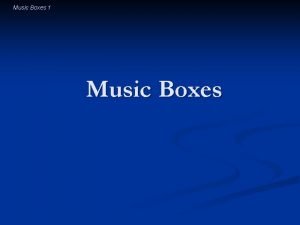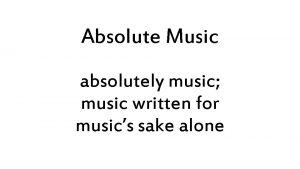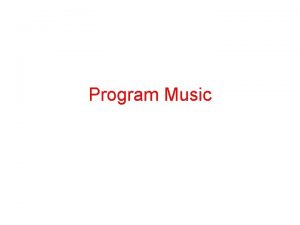Royalty Free Music for Schools Do You Have





























- Slides: 29

Royalty Free Music for Schools Do You Have the To Do a Podcast?

What is a Podcast? • A sound file that users can download from the internet. • Created by a podcaster (you!) who usually has something he or she wants to share. • Though the word podcast is usually associated with Apple’s i. Pod, a podcast can be listened to on any mp 3 player as long as it is in the appropriate file format.

Why are Podcasts Used? • Usually created by people who want to share something with the world – An opinion, new music, their opinion on new music, or any other ideas or instruction that can be distributed through audio format on the internet – Also being used by many schools to put class lectures in a portable format

Who Can Do a Podcast? Anyone! (With the proper equipment, a microphone and sound editing program)

Creating a Podcast 1. Record Your Audio 2. Add Music 3. Edit Your Podcast 4. Publish Your Podcast

What You Need • a microphone (internal or external) • Audacity software – free download at http: //audacity. sourceforge. net/ • LAME MP 3 encoder – free download at http: //audacity. sourceforge. net/help/faq? s=instal l&item=lame-mp 3 • Windows Media Player or i. Tunes

Before you record 1. Connect the microphone to the microphone-in connection on your PC. 2. Connect your headphones to the stereo line out or headphone jack. This is often the same jack.

Before You Record 3. Configure the microphone as your recording source. – Start > Control Panel > Sounds and Audio Devices – Click the Advanced button in the Device Volume section of the Sounds and Audio Devices control panel – With the Volume Control open choose Options > Properties from the menu and click the button next to recording

Before You Record 4. Prepare an outline (or a script) for your podcast! The recording process will go more smoothly if you know what you want to say.

Begin Your Project 1. Click File, Save Project As. . . 2. On the left side of the dialog box, click Desktop 3. Click the Create New Folder icon at the top of the dialog box, and name this folder. 4. With your new folder selected, click Open. 5. In the File Name box, name your podcast.

Adding Tracks • A Track stores the audio you are recording. • A new track is opened automatically for you each time you click the Record button. • To add a track manually, click Project, New Stereo Track from the menu.

Recording your Podcast 1. Push the record button and start talking. 2. When you finish recording press the stop button. 3. Save the file as a WAV. Record Play Skip to Start Stop Pause Skip to End

Add Music

WARNING IT IS NOT OK TO USE COPYRGHTED MUSIC WITHOUT WRITTEN PERMISSION FROM THE COPYRIGHT HOLDER(S). FAIR USE can not guarantee your protection when using copyrighted works in a public / broadcast environment. Section 6. 7 of FAIR USE states …

…” Fair use and these guidelines shall not preempt or supersede licenses and contractual obligations. ”





Add Music 1. Click Project, Import Audio on the menu. 2. Locate your music file on the desktop. 3. Select the file to import, then click Open.

Edit Your Podcast

Editing Tools Selection Tool: allows you to select audio Time Shift Tool: allows you to move audio to different parts of the audio track Delete: Copy: Paste: Select audio, Delete on your keyboard Select audio, Ctrl-C on your keyboard Ctrl-V on your keyboard

Arranging Your Tracks 1. Click the Time Shift Tool on the Audacity toolbar. 2. Select the track you want to move. 3. Click and drag to slide the audio track into the desired position.

Publish Your Podcast 1. Click File, Export as MP 3. – If a warning pops up that “Your tracks will be mixed down to two stereo channels in the exported file, ” just click OK. 2. Name your file and Save your mp 3 to your Desktop. – Do not save your mp 3 in the folder that ends in _data. This folder contains the files Audacity needs to edit your recording. Your mp 3 should be separate from these.





Links and Resources • http: //www. soundzabound. com • http: //audacity. sourceforge. net/help/faq? s=in stall&item=lame-mp 3 • www. soundzabound. com/services • www. soundzabound. com/tutorials
 Difference between royalty payable and royalty receivable
Difference between royalty payable and royalty receivable Free music for schools
Free music for schools Music music music
Music music music Have you free time
Have you free time Make me genius videos
Make me genius videos Samuel they have rejected me
Samuel they have rejected me Huntsvillecs.powerschool.com
Huntsvillecs.powerschool.com Reach target safety
Reach target safety Happy isles ulysses
Happy isles ulysses Right to recoup short working means
Right to recoup short working means Please feel free to interrupt me
Please feel free to interrupt me 8 faces 12 vertices 6 edges
8 faces 12 vertices 6 edges Romantic period instrument
Romantic period instrument Elements of music in art appreciation
Elements of music in art appreciation Music that employs electronic music
Music that employs electronic music Pamulinawen classification
Pamulinawen classification Should schools have dress codes essay
Should schools have dress codes essay Fspos
Fspos Novell typiska drag
Novell typiska drag Nationell inriktning för artificiell intelligens
Nationell inriktning för artificiell intelligens Ekologiskt fotavtryck
Ekologiskt fotavtryck Varför kallas perioden 1918-1939 för mellankrigstiden?
Varför kallas perioden 1918-1939 för mellankrigstiden? En lathund för arbete med kontinuitetshantering
En lathund för arbete med kontinuitetshantering Underlag för särskild löneskatt på pensionskostnader
Underlag för särskild löneskatt på pensionskostnader Tidbok för yrkesförare
Tidbok för yrkesförare Sura för anatom
Sura för anatom Vad är densitet
Vad är densitet Datorkunskap för nybörjare
Datorkunskap för nybörjare Tack för att ni lyssnade bild
Tack för att ni lyssnade bild Debattartikel mall
Debattartikel mall
